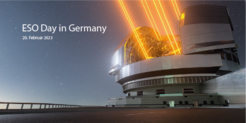ESO Day @ MPE
On 20 February 2023, representatives from science, industry, and politics celebrated the “ESO Day in Germany” at MPE to mark the 60th anniversary of the European Southern Observatory.

The European Southern Observatory (ESO) is the leading European organization for astronomical research and the most scientifically productive observatory in the world. The organization has 16 member countries: Austria, Belgium, the Czech Republic, Denmark, Finland, France, Germany, Ireland, Italy, the Netherlands, Poland, Portugal, Spain, Sweden, and Switzerland. In addition, there is the host country Chile and Australia as a strategic partner.
To mark ESO’s 60th anniversary, special celebrations are organised in each of the member countries; in Germany, representatives from science, industry and politics met at MPE to celebrate and discuss ESO’s special role. Nobel Laureate Prof. Reinhard Genzel, ESO Director General Prof. Xavier Barcons, junior scientist Dominika Wylezalek, and Thomas Westerhoff of Schott AG provided different insights into 60 years of top astronomical research.
Federal Research Minister Stark-Watzinger sent greetings, in which she particularly emphasized the role of astronomy in society: “Looking at the stars was always fascinating for people. Astronomy sparks enthusiasm for great scientific discoveries and shapes our understanding of the world as well as our culture. ESO is invaluable in this regard and, as the world’s leading organization for astronomy, strengthens Germany as a research location, which is why we support it with around 54 million euros annually. My sincere congratulations on the 60th anniversary to everybody involved.”

The panel discussion about the importance of research, science education and science communication for our society was also very lively. In addition to many examples of knowledge transfer, and generally the importance of basic research as a basis for innovation, the panellists found many links to art and culture and praised astronomy as a “training ground” for specialists in a wide range of industries. Furthermore, they suggested that the ESO model of international cooperation could be a template for many other areas and that citizen science (which has its roots in astronomy) could be expanded further.
ESO enables cutting-edge astronomical research by designing, constructing, and operating powerful ground-based telescopes. ESO has three observing sites in Chile that are unique in the world: La Silla, Paranal, and Chajnantor. At Paranal, ESO operates the Very Large Telescope (VLT), the world’s most powerful observatory for observations in visible light, and two telescopes for sky surveys: VISTA, the world’s largest survey telescope, operates in the infrared, while the VLT Survey Telescope (VST) is designed for sky surveys in visible light only. ESO is also a major partner in two projects on Chajnantor, APEX and ALMA, the largest astronomical project ever. On Cerro Armazones, not far from Paranal, ESO is currently building the 39-meter-diameter Extremely Large Telescope (ELT), which will one day become the largest optical telescope in the world.
As a founding member of ESO, host of the ESO headquarters in Garching, and one of the largest contributors, Germany plays a particularly important role. In addition, several institutes in Germany are involved in many important ESO projects and provide important components and instruments to make the best use of the ESO telescopes. For example, MPE developed the GRAVITY instrument, which interferometrically combines the four VLT telescopes, and is currently building the first-light camera for the ELT, MICADO. German researchers are involved in a majority of ESO observations and contributed to the top 10 ESO discoveries, most notably the 2020 Nobel Prize in Physics for the discovery of the black hole at the galactic center.













